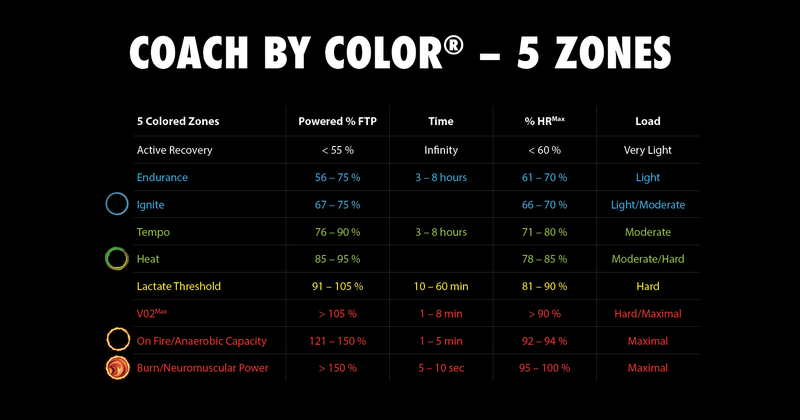ICG® App Support
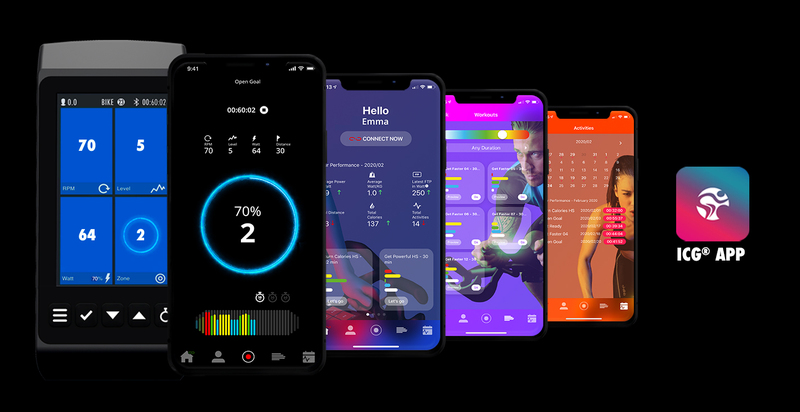
How do I pair the ICG® App with an indoor cycle?
Please make sure the indoor cycle you are riding has an IC5, IC6, IC7 or IC8 badge. This can be seen underneath the seat. To pair the ICG® App, firstly ensure Bluetooth is enabled on your device.
Connecting with a console with touch buttons (TFT 1.0 or LCD):
When you start pedaling your bike, the console will turn on and you will select the training mode you wish to use; Power Training, Heart Rate Training or FTP Power Tests. The App connection won´t work in Quick Start mode. After selecting a training mode, you will be asked if you would like to pair with the ICG® App. Select ‘Yes’ on the bike´s console. On your device, make sure Bluetooth is activated and open the ICG® App and select ‘Connect Bike’. A list of bike IDs will be displayed on your app and simply select the ID that matches the bike you are riding. You will now be asked if you would like to transfer your user data from the App to the console to skip entering metrics like weight, gender etc. which will generate your individual predicted FTP value. Select ‘Yes’ and start your training.
Connecting with a console with mechanical buttons (TFT 2.0):
When you start pedaling your bike, the console will turn on and show different training modes. Please open now the ICG® App on your device and make sure Bluetooth is activated. Select “Connect Now” on your device and choose the bike ID shown on the bike´s console and connect your App to the console. The console now shows a quick info text “App Connected”. Select now the training mode you wish to use: Quick Start, Power Training, Heart Rate Training or FTP Power Tests. After selecting a training mode all data will be transferred automatically from your device to the bike´s console. You can start your training now.
Where can I see my bike computer´s software version?
• Start pedaling your bike.
• When you can see the menu, press the button in middle and on the right for 5 seconds
• Now you can see the settings
• Open “Firmware” with one click on ✔
ICG® Workout Categories
Get Fitter – moderate intensity rides for base training with fundamental riding techniques
Burn Calories - interval workouts riding to mixed terrain using a variety of riding positions and RPMs
Get Stronger – strength workouts focusing on low to moderate climbing RPMs
Get Faster – speed workouts focusing on moderate to high RPMs
Get Powerful – High Intensity Training riding with moderate to high resistance and RPMs
ICG® Riding Techniques - technical key:
Seated Road (SERO):
This technique is ideal for warm-up, cool-down and recovery during an indoor cycling workout.
It is important to note the following:
Participants should ride with light to medium resistance.
This technique does not have to be delivered using beat matching the music. This type of riding is sometimes known as "let it roll". The pedal speed should be no higher than 100 RPM for L1 and120 RPM from L2 upwards. In the warm-up, a maximum pedal speed of 100 RPM applies at all levels. In the cool down, the speed should always be below 100 RPM.
Color Zones:
Warm Up: white – blue
Main Part: white – red

Cool Down: white – blue


Seated Climb (SECL):
The seated climb technique builds on the seated road. This exercise simulates riding uphill whilst seated. The cadence for the technique in the L1 and L2 class is a pedal speed of 50-72 RPM. At L3 and above the cadence can be extended to a pedal speed of 50-80 RPM.
Main Part: blue - red
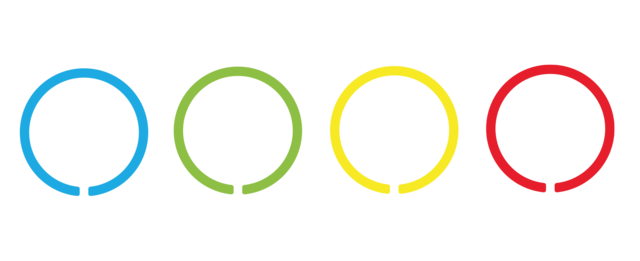

Standing Climb (STCL):
We always begin the standing section coming out of the Seated Climb. The cadence for this technique at L1 and L2 is 50-72 RPM. From L3 the cadence can be extended to a pedal speed of 50-80 RPM. At pedal speeds between 50-60 RPM, it is possible to simulate very steep mountain climbs. A higher resistance is used for this purpose.
Main Part: green - red
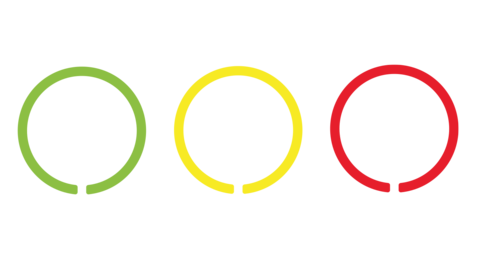

Jumps (JU):
Jumps consist of alternating between being seated and standing. The cadence for the technique is a pedal speed of 50-72 RPM for L1 and L2 and 50-80 RPM from L3 upwards. To get used to the movement we start with 16-beat intervals and then reduce to 8-beat and 4-beat intervals, depending on the ability level.
Main Part: green - red


Standing Jogging (STJO):
This position corresponds to standing climb and differs in terms of speed and resistance. The pedal speed is 80-100 RPM. Since the workload is high owing to the higher speed, the time intervals should not be too long.
Main Part: blue - red


Wave Riding (WR):
Here we simulate the movement of weight on the bike, such as when riding a forest trail, when riding down into a hole or down a staircase or ridge. The movement is made by shifting the buttocks backwards and forwards. The buttocks should always remain positioned above the saddle. The movements should be short, dynamic and fluid. The pedal speed is 50-80 RPM.
Main Part: green - red


Seated/ Standing Hillspeed Overtake (SE HSPO/ ST HSPO):
This technique simulates the overtaking of a slow group of cyclists on a mountain when seated or standing. We increase the resistance again shortly before increasing the speed. When performing the hill-speed technique, a maximum pedal speed of 120 RPM (seated) or 100 RPM (standing) is not exceeded. The mountain is ridden in the seated or standing climb positions with a pedal speed of 50-80 RPM. During the overtake phase, the pedal speed is increased to a maximum of 100/120 RPM.
Main Part – Seated: blue - red

Main Part – Standing: green - red


-
My device does not find the matching bike ID, what can I do?
First, ensure Bluetooth is enabled on both your device and the bike console. If both are enabled but your app is still not connecting, check your device for any other Bluetooth connections that may be interrupting the pairing process.

-
Where can I select and download workouts?
When you open the ICG® App, go to the workout section in the app where you will first select a workout category that suits your desired training goal. You can then filter the workouts for Intensity and Duration, the workouts will filter according to your selections and you can then choose your workout. Other workouts than the official ones provided by ICG® Master Trainers, must be created via the ICG® Workout Builder available on the ICG® Online Hub. Those individual created workouts could be shared via Facebook. Please visit the ICG® Hub Facebook group to find more workouts to download.

-
How do I record my workouts on my app?
Go to the third icon in the menu bar and select “Start Recording”. Make sure Bluetooth is enabled on your device and connect your bike with the ICG® App described in FAQ 1.
-
How can I build my own workouts?
If you would like to create your own indoor cycling workout routines, you can do this on our new platform available at https://www.teamicg.online/en/content/workoutbuilder/tool. Log in or sign up for an account to be able to access the ‘Workout Builder’ section where you can build and create your workouts.
If you would like to learn more about the ICG® Workout Builder, click here.

-
How can I change the App language?
When you are logged in to your ICG® App, open the profile section where you can access the app settings. You can then select the language you would like displayed on your app.
-
What is FTP?
FTP or Functional Threshold Power is defined as “FTP is defined as the highest average power output you can sustain for set period of time that has been derived from the original one-hour time trial test”
FTP is the best single marker for fitness in cycling. When you ride with a tested FTP, it will allow you to train effectively with our Coach by Color zones, ensuring you maximise your indoor cycling workouts when training with Power.
-
How can I test my FTP?
There are several different ways to test your FTP and the ICG indoor cycles have 2 tests available; FTP Ramp Test and FTP 5-minute Power Test. These tests are available on the console in the FTP Power Tests mode.
If you are new to riding with Power, it is recommended to start with the FTP Ramp Test as this test requires no previous experience of pacing and testing with Power. The ramp test will guide you to increase your target wattage every 4 minutes until you can no longer maintain the target. When you can no longer maintain the target watts, hit the ‘End Test’ button and your new FTP will be displayed on the console.
If you have experience of riding with Power and would like to perform the 5-minute Power Test, the ICG App offers warm up routines to ensure you are fully prepared to perform the max effort that is required throughout these tests.
-
How can I be part of the Global ICG® Instructor Club?
The Global ICG® Instructor Club offers excellent benefits like free licensed music downloads and you can sign up at here.

-
Can I add music to my workouts?
Unfortunately not. But you can integrate a track from you local PC to the workout builder to get the track length as well as the Title automatically. Click here to find out more about the Workout Builder. The track cannot be played in the App due to license rights. As member of the global ICG Instructor Club you will get free music downloads bimonthly. Learn more about the global ICG Instructor Club here: Global ICG® Instructor Club

-
Can I sync my workouts to Spotify?
As Spotify is a streaming provider for private use only, we do not support this function within the ICG® App. As instructor teaching in group studio classes, you must use special licensed music, hence Spotify should not be an option as it does not allow to use streamed music for commercial use.
![]()
-
How can I connect my bike to Zwift?
That depends on the console model on your bike.
Console models before 2020 (TFT 1.0 with touch buttons) are sending data via ANT+. If you want to connect the Zwift App on your Android device with the bike´s console please make sure you activate ANT+ signal within the Zwift App. When you start your training on your bike, the Zwift App will now receive data directly from the console. If you are an iOS user, you would need an extra ANT+ dongle on your device to receive the console´s signal.
New Wattrate TFT 2.0 console (mechanical buttons) sends data via Bluetooth 5.0, so you won´t need any extra equipment like ANT+ dongles to connect the console to your device.
-
How can I move my training data to Apple Health and other third-party apps?
When you are logged in to your ICG® App, open the profile section where you can access the app settings.
You can then select to send data to third party apps such as Apple Health.

-
Which Heart Rate chest belts can be paired with my bike?
The ICG® bike consoles pair with coded and non-coded analogue belts and all Bluetooth (BLE) belts.
Please check if your Heart Rate belt pairs with devices via either BLE or Analogue, this will ensure it is compatible with the ICG® console.
